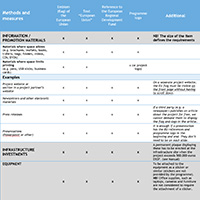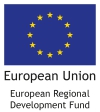This page summarises the requirements for references. In addition, we encourage you to review the following documents:
You can download the EU emblem and the programme logo directly from our webpage: http://centralbaltic.eu/document-categories/logos-and-maps
In the Programme Manual, the following is said about the correct use of references (ver. 2.4, p. 95)
Making sure the needed logos and references are in place is important. The cost of any material or information activity, such as a seminar organised by the project, that does not include the required references to EU and the programme, are not considered eligible and thus the project partner will not receive co-financing for these. An internal project meeting is not considered an information activity. As the absence of required references can have some rather severe (financial) consequences, be sure to use them. Remember to always check also the other co-financers’ publicity requirements and follow the national rules on publicity issues.
The needed references are the following:
The following points illustrate how the references and logos should be used for the different information materials, activities, equipment and infrastructure investments:

- The Programme Manual
- The overview table and
- The FAQ (provides case-specific examples).
You can download the EU emblem and the programme logo directly from our webpage: http://centralbaltic.eu/document-categories/logos-and-maps
The Programme Manual
Below we have attached a few sections from the Programme Manual to provide a quick view of the required references. For current information, please have a look at the latest Programme Manual, found on our webpage: http://centralbaltic.eu/document-categories/project-documentsIn the Programme Manual, the following is said about the correct use of references (ver. 2.4, p. 95)
Making sure the needed logos and references are in place is important. The cost of any material or information activity, such as a seminar organised by the project, that does not include the required references to EU and the programme, are not considered eligible and thus the project partner will not receive co-financing for these. An internal project meeting is not considered an information activity. As the absence of required references can have some rather severe (financial) consequences, be sure to use them. Remember to always check also the other co-financers’ publicity requirements and follow the national rules on publicity issues.
The needed references are the following:
- The flag of the EU together with the textual reference ‘European Union’
- Textual reference ‘European Regional Development Fund’
- The logo of the Central Baltic Programme 2014-2020
- The flag of the EU with the textual reference ‘European Union’ AND
- EITHER the Central Baltic Programme 2014-2020 logo OR
- The project’s own logo
The following points illustrate how the references and logos should be used for the different information materials, activities, equipment and infrastructure investments:
- Information materials have to contain the above-mentioned references to the funding source according to the size of and the space available on the information material.
- Websites: Information about the project and the received EU funding is to be published on each project partner’s website (aims, partners, amount of funding and its source, description of activities). Websites created with funding from the Central Baltic Programme 2014-2020 must contain all the above-mentioned references to the funding source at the start/main page. The EU flag, in colour, and text ‘European Union’ must be displayed on the front page without the reader having to scroll.
- Information activities: The organisers of events such as meetings, seminars, fairs and exhibitions, which are part of and co-financed within the project, have to show the link to the project and EU funding (see above for the required references)
- Infrastructure investments: An explanatory billboard as in the FAQ.
Overview table
The overview table provides required references at a glance. The file is available as jpg and pdf.


